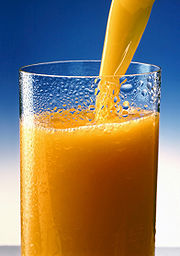Orange juice


Orange juice is a popular beverage made from oranges by extraction from the fresh fruit, by desiccation and subsequent reconstitution of the dried juice, or by concentration and subsequent addition of water to the concentrate. The term "orange juice" is also used, both colloquially and commercially, to refer to "concentrated orange juice".
Contents |
Health
Orange juice is a source of vitamin C (ascorbic acid), potassium, thiamine, Phosphorus G, folic acid (Vitamin B9) and vitamin B6. One 8-ounce (227 ml) glass of 100 percent orange juice counts as almost 25 percent of the USDA-recommended daily fruit and vegetable servings, based on a 2,000-calorie diet. Research shows orange juice is more nutrient dense than many commonly consumed 100 percent fruit juices, such as apple, grape, pineapple and prune.[1]
Citrus juices also contain flavonoids that are believed to have beneficial health effects. Orange juice containing pulp seems to be more nutritious than no-pulp varieties due to the flavonoids contained in the pulp.[2] If drunk on an empty stomach, orange juice can exacerbate present gastrointestinal conditions and/or cause mild and temporary stomach upset. Due to the citric acid, orange juice typically has a pH of 3.5.[3] Drinking or sipping orange juice can therefore cause erosion of the tooth enamel, otherwise known as 'acid erosion'. Some publications recommend using a straw when drinking orange juice so that the juice does not come into contact with the teeth.[4]
Commercial orange juice and concentrate
Frozen concentrated orange juice
When water is added to freshly-thawed concentrated orange juice, it is reconstituted.[5] Most of the orange juice sold today throughout the world is reconstituted juice.
The Intercontinental Exchange (ICE) trades FCOJ futures and options on futures. Several exchanges, including the Brazilian Mercantile and Futures Exchange, the New York Mercantile Exchange, and the Chicago Mercantile Exchange, have tried to co-list these contracts and steal the volume away from the ICE. (Needs foot notes and separate section.)
Process
Freshly squeezed juice and filtered orange juice is pasteurized and is evaporated under vacuum and heat to remove most of the water before it is frozen. The concentrated juice, about 65% by weight sugar, is then stored at about +10°F (-12°C). At this point essences and oils, recovered during the vacuum concentration process, are added back to restore the flavor. To make cans of frozen concentrate for sale, filtered water is added back to bring the mass faction of sugar down to 42%, about three times the concentration of fresh juice.
Canned orange juice
A small fraction of fresh orange juice is canned. Canned orange juice does retain Vitamin C much better than bottled juice. However, the canned product loses flavor when stored at room temperature for over 12 weeks.[6]
Major orange juice brands
In the US, the major orange juice brand is Tropicana Products (owned by PepsiCo Inc.), which possesses nearly 65% of the market share. Tropicana also has a large presence in Latin America, Europe and Central Asia. Competing products include Simply Orange (owned by the Minute Maid division of The Coca-Cola Company) and Florida's Natural (a Florida-based agricultural cooperative that differentiates itself from the competition by using only Florida grown oranges; Tropicana and Simply Orange use a mix of domestic and foreign stock).
In Australia, Daily Juice (owned by National Foods) is a major brand of partially fresh partially preserved[7] orange juice. The Original Juice Co. (owned by Golden Circle produced a fresh no-concentrate (with no preservatives) form of juice marketed as part of their 'Black Label' range of juice products. Both these products, along with other brands are sold in the refrigerated section of supermarkets throughout Australia.
Additives
Some producers add citric acid or ascorbic acid to juice beyond what is naturally found in the orange. Some also include other nutrients such as calcium and Vitamin D, not found naturally in oranges. Low-acid varieties of orange juice are also available. Omega-3 is sometimes added to orange juice from fish oils.[8]
Color
Orange juice usually varies between shades of orange and yellow, though some ruby red or blood orange varieties are a reddish-orange or even pinkish. This is due to different pigmentation in ruby red oranges.
References
- ↑ Rampersaud, GC (2007). A comparison of nutrient density scores for 100% fruit juices. Journal of Food Science 72(4)261-266.
- ↑ "Is fruit juice as good as whole fruit". World's Healthiest Foods. http://www.whfoods.com/genpage.php?tname=george&dbid=74. Retrieved 2007-04-13.
- ↑ "Acids". British Soft Drinks Association. http://www.britishsoftdrinks.com/htm/qa/AdditivesIngredients/acids/acids.htm. Retrieved 2006-09-12.
- ↑ "Acid erosion and abrasion:Prevention". aciderosion.co.uk. http://www.aciderosion.co.uk/erosion/prevention.aspx.
- ↑ To prevent off-flavor, distilled or reverse osmosis filtered water should be used when reconstituting frozen juice, devoid of minerals, chlorine, etc.
- ↑ Yiu H. Hu, József Barta Handbook of Fruits and Fruit Processing. Blackwell Publishing, 2006. p. 327.
- ↑ Statement from National Foods
- ↑ New York Times Article on Orange Juice Additives
External links
- Orange juice production Production process and distinction between juice products.
- Brief film clip of orange juice processing from 1968. From the State Library & Archives of Florida.
- Natural orange juice processing Industrial processing of natural orange juice.
- Orange Juice Facts Learn more about orange juice.
|
|||||||||||